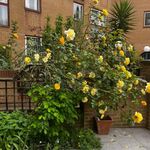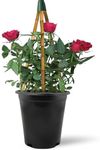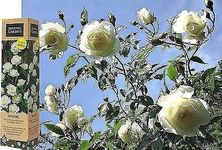Buying Guide for the Best Climbing Roses
Choosing the right climbing roses for your garden can transform your outdoor space into a beautiful, fragrant haven. Climbing roses are versatile plants that can cover walls, fences, and trellises, adding vertical interest and color. When selecting climbing roses, consider factors such as climate, space, and maintenance preferences to ensure you choose a variety that will thrive in your garden and meet your aesthetic desires.Climate SuitabilityClimate suitability refers to how well a climbing rose variety can thrive in your local weather conditions. This is important because roses that are not suited to your climate may struggle to grow, bloom less, or be more susceptible to diseases. Climbing roses are generally divided into categories based on their hardiness zones, which indicate the minimum temperatures they can withstand. If you live in a colder region, look for roses that are hardy to your zone. Conversely, if you live in a warmer area, choose varieties that can tolerate heat and humidity. Consider your local climate and choose a climbing rose that is known to perform well in those conditions.
Blooming FrequencyBlooming frequency describes how often a climbing rose produces flowers throughout the growing season. This is important because it affects how long your garden will be adorned with blooms. Climbing roses can be categorized into once-blooming and repeat-blooming varieties. Once-blooming roses typically flower in a single, spectacular display in late spring or early summer, while repeat-blooming roses continue to produce flowers throughout the season. If you prefer a garden that has continuous color, opt for repeat-blooming varieties. If you enjoy a dramatic, seasonal display, a once-blooming rose might be more suitable.
Growth HabitGrowth habit refers to the way a climbing rose grows and spreads. This is important for determining how much space the plant will need and how it can be trained to cover structures. Climbing roses can vary in their growth habits, with some being more vigorous and others more compact. Vigorous climbers can cover large areas quickly and are ideal for big spaces or tall structures. More compact varieties are better suited for smaller gardens or limited spaces. Consider the area you want to cover and choose a climbing rose with a growth habit that matches your space and design goals.
Disease ResistanceDisease resistance indicates how well a climbing rose can withstand common rose diseases such as black spot, powdery mildew, and rust. This is important because disease-resistant roses require less maintenance and are more likely to thrive without the need for chemical treatments. Climbing roses with high disease resistance are ideal for gardeners who prefer low-maintenance plants or who live in areas prone to these diseases. If you want a rose that is easy to care for and less susceptible to disease, look for varieties that are specifically bred for resistance.
FragranceFragrance refers to the scent produced by the climbing rose's blooms. This is important for gardeners who want to add an aromatic element to their garden. Climbing roses can range from having no scent to being highly fragrant. If fragrance is a priority for you, choose varieties known for their strong, pleasant scent. Consider how you plan to use the space; for example, if the rose will be near a seating area or walkway, a fragrant variety can enhance the sensory experience of the garden.
ColorColor refers to the hue of the climbing rose's blooms. This is important for achieving the desired aesthetic in your garden. Climbing roses come in a wide range of colors, from classic reds and pinks to whites, yellows, and even multi-colored varieties. When choosing a color, consider the existing color scheme of your garden and how the rose will complement or contrast with other plants. Select a color that aligns with your personal taste and the overall design of your outdoor space.
















